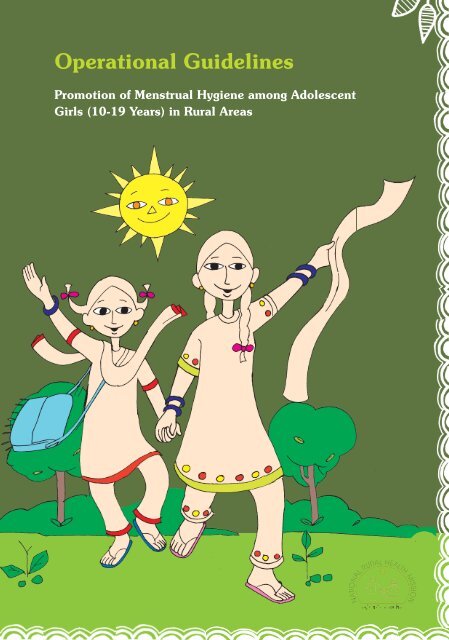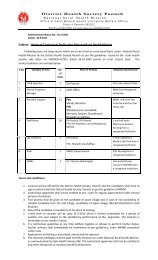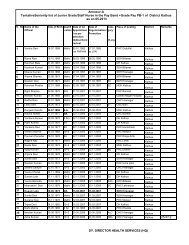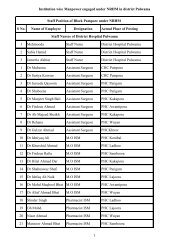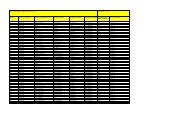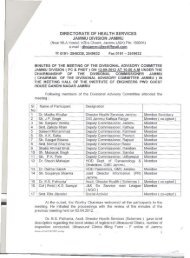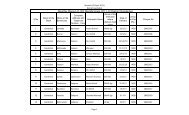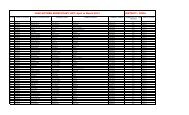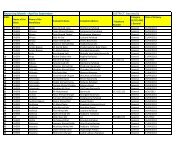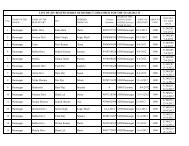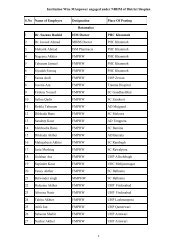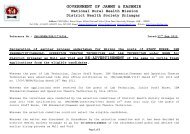Operational Guidelines for Promotion of Menstrual Hygiene among
Operational Guidelines for Promotion of Menstrual Hygiene among
Operational Guidelines for Promotion of Menstrual Hygiene among
You also want an ePaper? Increase the reach of your titles
YUMPU automatically turns print PDFs into web optimized ePapers that Google loves.
<strong>Operational</strong> <strong>Guidelines</strong><strong>Promotion</strong> <strong>of</strong> <strong>Menstrual</strong> <strong>Hygiene</strong> <strong>among</strong> AdolescentGirls (10-19 Years) in Rural Areas
ContentsI. Introduction & Rationale 5II. Objectives <strong>of</strong> the Programme 5III. Target Groups 6IV. Overall Strategy 7V. Selection <strong>of</strong> Districts 7VI. Components <strong>of</strong> the Programme 8VII. Service Delivery Framework 12VIII. <strong>Operational</strong>isation <strong>of</strong> the Programme 14IX. Management Structure 16X. Monitoring and Supervision 17XI. Non-negotiable in Programme Implementation 19Annexure 1 20Annexure 2 22
<strong>Operational</strong> <strong>Guidelines</strong>I. Introduction and RationaleThe Adolescent Reproductive and Sexual Health (ARSH) and the AdolescenceEducation Programme (AEP) are core components <strong>of</strong> national health programmesthat address adolescent health. Both these programmes include a range <strong>of</strong>interventions <strong>for</strong> adolescent girls and boys who are in school and out <strong>of</strong> school.This scheme <strong>for</strong> promotion <strong>of</strong> menstrual hygiene builds on and strengthensinterventions <strong>for</strong> adolescent girls by creating a <strong>for</strong>um <strong>for</strong> discussion on adolescenthealth related issues such as early age at marriage, nutrition, gender issues,contraceptives, self-esteem and negotiation skills, making available in<strong>for</strong>mationand products related to improved menstrual hygiene.In India, menstruation and menstrual practices are clouded by taboos andsocio-cultural restrictions <strong>for</strong> women as well as adolescent girls. Limited accessto products <strong>for</strong> sanitary hygiene, and lack <strong>of</strong> safe sanitary facilities could proveto be barriers to increased mobility and the likelihood <strong>of</strong> resorting to unhygienicpractices to manage menstruation. Traditionally in India, it appears that there aresome strategies: 1 use <strong>of</strong> old clothes as pads by recycling them, and use <strong>of</strong> ash orstraw, which <strong>of</strong>fers no protection, and endangering menstrual hygiene with longterm implications <strong>for</strong> reproductive health.Anecdotal evidence suggests that the lack <strong>of</strong> access to menstrual hygiene (whichincludes sanitary napkins, toilets in schools, availability <strong>of</strong> water, privacy and safedisposal) could constrain school attendance and possibly contribute to localinfections during this period. There<strong>for</strong>e, creating awareness and increasing accessto the requisite sanitary infrastructure related to menstrual hygiene is important.II. Objectives <strong>of</strong> the ProgrammeThe programme will be focused in rural areas with the following objectives:• To increase awareness <strong>among</strong> adolescent girls on menstrual hygiene, buildself-esteem, and empower girls <strong>for</strong> greater socialisation• To increase access to and use <strong>of</strong> high quality sanitary napkins by adolescent girlsin rural areas• To ensure safe disposal <strong>of</strong> sanitary napkins in an environment friendly manner.1The Gendered Dimension <strong>of</strong> Basic Needs: Exploring <strong>Menstrual</strong> <strong>Hygiene</strong> and Reproductive Infections : VanithaNayak Mukherjee, Final Report to the MacArthur Foundation5
<strong>Operational</strong> <strong>Guidelines</strong>III. Target GroupThis programme will be targeted at adolescent girls in the age group <strong>of</strong> 10-19years, residing in rural areas, to ensure that they have adequate knowledge andin<strong>for</strong>mation about the use <strong>of</strong> sanitary napkins, that high quality safe products aremade available to them, and that environmentally safe disposal mechanisms arereadily accessible. Based on data from Census 2001, there are an estimated225 million adolescents comprising nearly one-fifth (22%) <strong>of</strong> India’s totalpopulation. The projected rural population <strong>of</strong> girls (10-19 years) is 8.55 crore, <strong>of</strong>which 2.42 crore belong to the Below Poverty Line (BPL) category and 6.13 crore tothe Above Poverty Line (APL) category.In the first phase, 150 districts are to be covered, i.e there will be 25% geographiccoverage. There<strong>for</strong>e, <strong>of</strong> the total adolescent girl population <strong>of</strong> 8.55 crore girls, thecoverage (at 25%) <strong>for</strong> the first year amounts to 2.14 crore girls in the target group.Assuming that approximately 70% <strong>of</strong> population <strong>of</strong> 2.14 crore <strong>of</strong> adolescentgirls is to be reached, and given varying ages <strong>of</strong> onset <strong>of</strong> menarche between10-12 years, the calculation in this programme is based upon a target population<strong>of</strong> 1.5 crore girls in the age group <strong>of</strong> 10-19 years. Out <strong>of</strong> these 1.5 crore girls, theapproximate proportion <strong>of</strong> APL girls is about 70% (105 lakh) and that <strong>of</strong> BPL girls is30% (45 lakh).2Projected population <strong>for</strong> India and states (2001-2026), National Commission on Population6
<strong>Operational</strong> <strong>Guidelines</strong>IV. Overall StrategyThe scheme adopts two key strategies:• Demand generation through ASHA and other communitymechanisms such as Women’s Groups/Kishori Mandals. Anadditional mechanism <strong>for</strong> in-school youth would be that <strong>of</strong> theAEP through the life skills courses <strong>for</strong> Classes IX and XI.• Supply side intervention through ensuring a supply <strong>of</strong> aproduct (sanitary napkin) which is reasonably priced and <strong>of</strong>high quality.V. Selection <strong>of</strong> DistrictsThe initiative will be rolled out in phases, with 25% <strong>of</strong> the country being covered inthe first phase, i.e. 150 districts in selected states.The following criteria are suggested to the states <strong>for</strong> selection <strong>of</strong> districtswhere this intervention may be taken up:• Existing adolescent health programme• Strong AEP intervention• Active Self-Help Group (SHG) federations• Effective ASHA training and support systems.In the selected districts, the states would cover approximately 70% <strong>of</strong> theadolescent girl population because <strong>of</strong> the varying ages <strong>of</strong> onset <strong>of</strong> menarchebetween 10-12 years.7
<strong>Operational</strong> <strong>Guidelines</strong>VI. Components <strong>of</strong> the ProgrammeThe various components <strong>of</strong> the programme and its operational steps are outlinedbelow:1. Community-based health education and outreach in thetarget population to promote menstrual healtha. Outreach through ASHA/other community mechanismsThe outreach to adolescent girls will be through:• Monthly meetings to be convened by ASHA at the Anganwadi Centre orPanchayat Bhavan <strong>for</strong> adolescent girls in the target age group. The monthlymeeting can also be held with the Kishori Samooh or the Adolescent ResourceCentre proposed under the SABLA scheme - Rajiv Gandhi Scheme <strong>for</strong>Empowerment <strong>of</strong> Adolescent Girls (RGSEAG) by the Ministry <strong>of</strong> Women andChild Development (MWCD). Sunday is suggested as a day to hold the meetingas it will ensure that both in-school and out-<strong>of</strong>-school girls can attend. ASHAwill be paid an incentive from the Village Health and Sanitation Committee(VHSC) funds <strong>for</strong> conducting each monthly meeting. But states can select analternative to this.• Monthly meetings should be complemented by household visits to promotemenstrual hygiene <strong>among</strong> girls who are unable to attend the monthly meetingand motivate attendance <strong>for</strong> future meetings.The meeting will focus on issues <strong>of</strong> menstrual hygiene and also serve as a <strong>for</strong>um<strong>for</strong> supplying sanitary napkins to the girls. In addition, other issues that impactadolescent health such as: early marriage, nutrition, gender issues, knowledge<strong>of</strong> contraceptive choices, understanding <strong>of</strong> Sexually Transmitted Infection (STI)including HIV and the consequences <strong>of</strong> high risk behaviour, improving self-esteemand negotiation skills will be discussed.States can choose to involve other community-based groups such as SHGs/Community-Based Organisations (CBOs) in the process <strong>of</strong> mobilisation andawareness creation <strong>for</strong> menstrual hygiene promotion.b. Outreach through schoolsAnother channel <strong>for</strong> promotion <strong>of</strong> menstrual hygiene <strong>for</strong> school going adolescentscould be the AEP/School Health <strong>Promotion</strong> and the nodal school teachers.8
<strong>Operational</strong> <strong>Guidelines</strong>2. Ensuring regular availability <strong>of</strong> sanitary napkins to the adolescentsa. In the communityAt the community level, the ASHA will be responsible <strong>for</strong> ensuring an adequate supply<strong>of</strong> sanitary napkins to adolescent girls who require them. The monthly meetingswould be the key <strong>for</strong>um to facilitate this regular supply. Girls who are at homes andunable to attend these monthly meetings will be reached through home visits toensure supply <strong>of</strong> sanitary napkins. The role <strong>of</strong> ASHA in supplying the sanitary napkinsis a suggested option. States are free to select other mechanisms <strong>for</strong> reaching theadolescent girls in order to provide them with sanitary napkins which may be bettersuited to the local context.b. In the schoolBased on existing data, it can be assumed that approximately 45% <strong>of</strong> the ruraladolescent girl population is in school and the remaining is out <strong>of</strong> school. Thus, healtheducation and supply and distribution <strong>of</strong> sanitary napkins both can be done throughthe mechanisms <strong>of</strong> the AEP/School Health Programme. Orientation <strong>of</strong> nodal teachersand school principals will have to be conducted through the existing mechanisms.The nodal teachers would be made responsible <strong>for</strong> storage <strong>of</strong> sanitary napkins,maintaining record <strong>of</strong> use and <strong>for</strong> safe disposal. The provision <strong>of</strong> separate toilets <strong>for</strong>girls and incinerators <strong>for</strong> safe disposal <strong>of</strong> sanitary napkins will also need to be made.3. Sourcing and procurement <strong>of</strong> sanitary napkinsThe requirement <strong>of</strong> sanitary napkins <strong>for</strong> each selected district is based on 70% <strong>of</strong> thetotal population <strong>of</strong> adolescent girls in the age group 10-19 years. These guidelinesstipulate that each pack <strong>of</strong> sanitary napkins will contain six napkins.The sanitary napkins shall be sourced through the following ways:• Through enabling manufacture by SHGs in states. Under various nationaland state programmes under Women and Child Development, RuralDevelopment, Social Welfare, and Women’s Development Corporations,SHGs are fairly widespread and active. This method <strong>of</strong> procurement willbe applicable in 50 districts where SHG presence is strong and wherethere are Self Help Groups already manufacturing sanitary napkins orhave the capacity to do so.• Sourcing sanitary napkins through manufacturers through acompetitive bidding process – This can be done in the 100 districtsin Central, Northern and North-Eastern states, where SHGs may not yethave matured or are non-existent.9
<strong>Operational</strong> <strong>Guidelines</strong>If the SHG route is selected, states would need to ensure that SHGs have accessto: bank finance, micro financing institutions and linkages to other programmesthat <strong>of</strong>fer subsidies and capacity building to Self Help Groups in order to take upproduction <strong>of</strong> sanitary napkins.Over time, states should develop mechanisms so that SHGs are strengthened tosupply the sanitary napkins.States will need to put into place uni<strong>for</strong>m standards <strong>for</strong> production and qualitychecks to ensure safety <strong>of</strong> the product in line with the prescribed standards. Thiswould require that the state involves local technology institutions <strong>for</strong> materialtesting and Research and Development (R&D) by establishing quality testing labsand ensuring quality measures <strong>for</strong> infection prevention during manufacture.4. Training <strong>of</strong> ASHA in menstrual hygieneI. Trainers(i) State level trainers: At the state level, four trainers will be selected, preferablywomen, with about 10 years experience in training on women’s reproductivehealth issues, and an understanding <strong>of</strong> working with grass roots workers suchas Auxiliary Nurse Midwife (ANM), ASHA, Anganwadi Workers (AWW).(ii) ASHA trainers: Each district will select two ANMs/LadyHealth Visitors (LHVs) from each block, preferably thosewho have participated in earlier ASHA trainings. Thus,20 trainers per district (assuming a normative district has10 blocks) will be selected. These trainers will train theASHA <strong>of</strong> their respective blocks.II. Where will they be trained?(i) State trainers will be trained by NHSRC at the national levelin a one-day workshop.(ii) The 20 block trainers will be trained at the state/districtlevel by the state trainers.III. ASHA trainingFor purposes <strong>of</strong> calculation, it is assumed that each block has100 ASHAs and five facilitators. These can be divided intothree batches <strong>of</strong> 35 each. The training duration <strong>for</strong> a batch isabout four hours. The three batches <strong>of</strong> ASHA will be trained atthe block level by a team <strong>of</strong> two district trainers, who belongto that block.10
January 1 2 3 4 5 6 7 8 9 10 11 12 13 14 15 16 17 18 19 20 21 22 23 24 25 26 27 28 29 30 31February 1 2 3 4 5 6 7 8 9 10 11 12 13 14 15 16 17 18 19 20 21 22 23 24 25 26 27 28March 1 2 3 4 5 6 7 8 9 10 11 12 13 14 15 16 17 18 19 20 21 22 23 24 25 26 27 28 29 30 31April 1 2 3 4 5 6 7 8 9 10 11 12 13 14 15 16 17 18 19 20 21 22 23 24 25 26 27 28 29 30May 31 1 2 3 4 5 6 7 8 9 10 11 12 13 14 15 16 17 18 19 20 21 22 23 24 25 26 27 28 29 30June 1 2 3 4 5 6 7 8 9 10 11 12 13 14 15 16 17 18 19 20 21 22 23 24 25 26 27 28 29 30July 1 2 3 4 5 6 7 8 9 10 11 12 13 14 15 16 17 18 19 20 21 22 23 24 25 26 27 28 29 30 31August 30 31 1 2 3 4 5 6 7 8 9 10 11 12 13 14 15 16 17 18 19 20 21 22 23 24 25 26 27 28 29September 1 2 3 4 5 6 7 8 9 10 11 12 13 14 15 16 17 18 19 20 21 22 23 24 25 26 27 28 29 30October 1 2 3 4 5 6 7 8 9 10 11 12 13 14 15 16 17 18 19 20 21 22 23 24 25 26 27 28 29 30 31November 1 2 3 4 5 6 7 8 9 10 11 12 13 14 15 16 17 18 19 20 21 22 23 24 25 26 27 28 29 30December 1 2 3 4 5 6 7 8 9 10 11 12 13 14 15 16 17 18 19 20 21 22 23 24 25 26 27 28 29 30 31<strong>Operational</strong> <strong>Guidelines</strong>The ASHA will be given a copy <strong>of</strong> the flipbook and reading material, andthe trainers will be given the trainer module in addition. The readingmaterial and trainer module can also be used to train SHGs and AWWs ifthe state so chooses.vk’kkfyi cqd5. Behaviour Change CommunicationA communication strategy and a kit targeted at adolescent girls andgatekeepers and influencers (mothers, teachers, women members <strong>of</strong>PRI and VHSC) will be developed at the national level <strong>for</strong> translationand adaptation at state levels. The mechanisms <strong>for</strong> Behaviour ChangeCommunication (BCC) will include Interpersonal Communication (IPC),use <strong>of</strong> Flipcharts and Leaflets, and Health Camps. Messages on <strong>Menstrual</strong>Health will be incorporated in the existing In<strong>for</strong>mation, Education andCommunication (IEC) campaigns under the National Rural Health Mission(NRHM), being undertaken by the IEC Division <strong>of</strong> the Ministry <strong>of</strong> Healthand Family Welfare (MoHFW) with adaptation at state level.2010Mon Tue Wed Thu Fri Sat Sun Mon Tue Wed Thu Fri Sat Sun Mon Tue Wed Thu Fri Sat Sun Mon Tue Wed Thu Fri Sat Sun Mon Tue Wed Thu Fri Sat Sun6. Safe disposal <strong>of</strong> sanitary napkinsfpadh] fiadh lax lgsyhukps&xk;s djs vV[ksyhchrs gekjk gj fnuLoLFk] lqjf{kr] fparkfcuSafe disposal <strong>of</strong> sanitary napkins is an integral part <strong>of</strong> the programme,particularly given the consequences <strong>for</strong> the environment. Safe disposalcommunication will be one <strong>of</strong> the core components <strong>of</strong> the BCC training.At the community level, deep pit burial or burning are two options whichcould be considered after due environmental clearances are obtained.States could consider installing incinerators in schools. Incineratorsrange from manually operated to those that employ more sophisticatedtechnologies. States could leverage funding <strong>for</strong> such equipment throughthe Total Sanitation Campaign (TSC) or Sarva Shiksha Abhiyan (SSA). bLrseky fd;s gq;s lSfuVjh uSifdu dks vPNs lsdkxt+ esa yisV dj] dwM+snku esa gh Qsaduk pkfg,A ekfld /keZ ds nkSjku vius futh vaxksa dksle;≤ ij lkQ djuk pkfg, o tc HkhuSifdu cnys] gkFk lkcqu ls /kksus pkfg,A ekfld /keZ ds nkSjku lkQ ikuh ls t+:j Lukudjuk pkfg,A ekfld /keZ esa lSfuVjh uSifdu dk bLrseky t:jdjuk pkfg,A ;g xhykiu lksdus dk ,d lkQ olqjf{kr mik; gSA lSfuVjh uSifdu vkidks vk'kk nhnh ds ikl feyldrs gSA lSfuVjh uSifdu dks LoPN o lkQ txg esa j[kukpkfg,A uSifdu xhyk gks tkus ij rqjUr gh cnyuk pkfg,AEkkfld /keZ esa [;ky j[ksaEkkfld /keZ ,d yM+dh ds 'kjhj esa gksus okyh lkekU; fLFkfr gS vkSj fd'kksjkoLFkk esa izR;sd yM+dh bldk vuqHkodjrh gSA ekfld /keZ 10&16 lky dh mez esa 'kq: gksdj 40&45 lky dh mez esa lekIr gksrk gSA ;g izfØ;k gj28&40 fnuksa ds chp esa gksrh gSA ;g c
<strong>Operational</strong> <strong>Guidelines</strong>VII. Service Delivery Framework: Roles andResponsibilities at Various Service Delivery LevelsLevel <strong>of</strong>CareService ProviderService PackageVillage ASHA/SHGs/CBOs • Mobilise adolescent girls.• Conduct monthly meetings.• Provide health education toadolescent girls.• Conduct women’s group meetings.• Distribute sanitary napkins toadolescent girls.• Ensure regular refill and supply <strong>of</strong>sanitary napkins to the village fromthe Sub-Centre.• Sell sanitary napkins and maintainaccounts.• Track supplies and estimaterequirement <strong>for</strong> the following month.• Submit progress report on keyindicators.Sub-CentreANMs • Training <strong>of</strong> the ASHA on menstrualhygiene booklet, and conductperiodic refreshers.• Monitor the monthly meetingsperiodically.• Transport the sanitary napkin stockfrom block PHC to Sub-Centre.• Ensure safe storage <strong>of</strong> the sanitarynapkin stock.• Supply requisite number <strong>of</strong> sanitarynapkin packs to ASHA in herSub-Centre area.• Provide imprest funds andtransportation costs to ASHA.• Conduct spot checks during regularfield visits and Village Health andNutrition Day (VHND).• Review and validate ASHA trackingsystem and accounts register.• Maintain inventory, tracking andaccounts register.12
<strong>Operational</strong> <strong>Guidelines</strong>PHCMO/Block AccountsOfficer• Ensures that ASHA training onmenstrual hygiene takes place.• Ensure safe storage <strong>of</strong> sanitarynapkins.• Conduct spot checks during regularfield visits.• Maintain inventory, tracking andaccounts-register.District CMHO/CS/DPM • Serve as the nodal point <strong>for</strong> theprogramme.• Engage the services <strong>of</strong> a bookkeeperon a contractual basis to train MO/Block Accounts Officer and ANM in allblocks on maintaining inventory andaccounts <strong>for</strong> the scheme.• Ensure remittance <strong>of</strong> funds obtainedto District Health Society through theblock.• Ensure safe storage <strong>of</strong> sanitarynapkins.• Monitor the programme on a regularbasis.Collector/AdditionalCollector• Monthly programme and financialreview <strong>of</strong> the scheme along withother health programmes.• Manage convergence <strong>of</strong> variousdepts.State Mission Director, NRHM • Organise sourcing <strong>of</strong> sanitary napkinsfrom SHGs/bidding process.• Set up quality cell to ensurecon<strong>for</strong>mity with prescribed standards.• Ensure sound logistics systems <strong>for</strong>smooth supply to district and below.Annexure 1: Roles and Responsibilities at Various Levels13
<strong>Operational</strong> <strong>Guidelines</strong>VIII. <strong>Operational</strong>isation <strong>of</strong> the Programme at theDistrict and Sub-District LevelsThe steps <strong>of</strong> operationalisation <strong>of</strong> the programme at District, Block, Sub-Centre andVillage levels is detailed below. A state steering committee will be set up to takedecisions regarding state specific modifications. (such as the sanitary napkin packsbeing sold at same or differential price by the ASHA).Step 1:Step 2:Step 3:Step 4:Step 5:Step 6:Step 7:Step 8:Step 9:Step 10:Sanitary napkins are supplied to the block warehouse. Storage willneed to be organised by states at the block level. Such storage needsto be clean, dry, rodent-free and secure.The ANM will collect the sanitary napkins from the block duringher monthly meeting visit and transport it to the Sub-Centre. Evenwhen packaged <strong>for</strong> delivery at the level <strong>of</strong> the PHC, the commodityis lightweight but bulky, needing adequate space which is free <strong>of</strong>moisture and pests/rodents. It will be stored at the Sub-Centre or at aplace rented <strong>for</strong> this particular purpose, if the space in the Sub-Centreis insufficient. Such storage will need to be organised by States.The ANM will provide the ASHA with a one-time imprest fund <strong>of</strong>Rs. 300 (or more if decided by the State Steering Committee) whichshe will take from the untied funds pool <strong>of</strong> the Sub-Centre.The ASHA will use the imprest funds to purchase sanitary napkins fromthe ANM. ASHA will also get a pack <strong>of</strong> sanitary napkins free every month<strong>for</strong> her own use to be able to become an effective change agentThe ASHA will sell sanitary napkins to the adolescent girls at a pricedecided by the Government.In case ASHA is selling the sanitary napkin packs, she will retain anincentive <strong>for</strong> every pack sold, the incentive amount being decided bythe State Steering Committee.The ASHA will retain the amount recovered from the sale to replenishthe imprest amount which the ASHA will use <strong>for</strong> subsequent purchase.The ANM will deposit the funds obtained from the sale <strong>of</strong> napkins tothe ASHA in the united funds <strong>of</strong> the Sub-Centre.These funds will be used <strong>for</strong> meeting the costs <strong>of</strong> transportation fromBlock to Sub-Centre and then to the village and rental to store thesanitary napkins at the Sub-Centre level if required.The balance fund, if any after, meeting the above costs will be returnedto the District Health Society through the block. The District HealthSociety should use these funds <strong>for</strong> programmes <strong>for</strong> adolescents.14
<strong>Operational</strong> <strong>Guidelines</strong>At the village level, the ASHA will maintain a register <strong>of</strong> sales <strong>of</strong>APL and BPL girls (in case the state decides to have differentialpricing <strong>for</strong> both) which will be verified and certified by at leasttwo women members <strong>of</strong> the VHSC to ensure that the salesto the APL and BPL girls are made in accordance with theguidelines.Illustrative calculation <strong>for</strong> one ASHA is as follows (in case the state decides to fix aprice <strong>for</strong> the sanitary napkins):• For the first month, the ASHA will purchase approximately Rs. X worth <strong>of</strong>sanitary napkins from the ANM.• At the village, every month, she will sell the sanitary napkins to the APL and BPLadolescent girls at a reasonable price decided by the Government.• This would give her some monthly incentive and some amount to ploughback into the imprest money which would be used as a revolving fund <strong>for</strong>subsequent purchases.• For organising the adolescent girls’ education sessions on one day everymonth, the ASHA will receive a certain pre-determined incentive as well (asfixed by the State Steering Committee). This will be reimbursed only after theverification <strong>of</strong> the reports.School-based distribution: Existingmechanisms <strong>of</strong> the School Health Programmemay be used when sanitary napkins are tobe distributed through the school route toensure supply <strong>of</strong> commodities. The SchoolHealth Programme team will ensure handingover <strong>of</strong> the commodity to the nodal ladyteachers in the schools. States and districtscould consider installation <strong>of</strong> vendingmachines <strong>for</strong> sanitary napkins, depending onstate context. Leveraging <strong>of</strong> funds <strong>for</strong> thiscould be from the SSA.15
<strong>Operational</strong> <strong>Guidelines</strong>IX. Management StructureThe programme will be administered as part <strong>of</strong> the NRHM programme at the stateand district levels. The implementation <strong>of</strong> the programme will be through the Stateand District Health Societies. The final delivery point <strong>for</strong> the adolescent girl wouldbe the ASHA/school teacher/other community-based mechanisms.Supply & Storage ChainCommercial ManufacturesStorageStorageStorageStateDistrictBlockSHCVillageSHGsSupply to the block can be made directlyfrom state or it can be through districtANM collects from BPHC/CHCASHA collects from SHCThe programme would require convergence with other departments suchas: Education, Water and Sanitation, Women and Child Development, RuralDevelopment, Social Welfare, Youth and Sports Affairs, Social Justice andEmpowerment <strong>for</strong>:• Leveraging <strong>of</strong> funds <strong>for</strong> financing <strong>of</strong> SHGs to manufacture sanitary napkins• Procurement <strong>of</strong> vending machines and incinerators• Involvement <strong>of</strong> SHGs and institutions such as girls hostels and orphanages• Distribution <strong>of</strong> sanitary napkins to the adolescent girls• Construction <strong>of</strong> toilets <strong>for</strong> girls, etc.At the national level, the Secretary, HFW will convene a meeting <strong>of</strong> thedepartments mentioned above in order to ensure convergence at the highest level.This will be replicated at the state level as well.At the state level, a State Steering Committee is proposed to be <strong>for</strong>med inevery state <strong>for</strong> the operationalisation <strong>of</strong> the Scheme <strong>for</strong>implementation <strong>of</strong> menstrual hygiene. The Committeewould be responsible <strong>for</strong> the following tasks:• Finalise the price <strong>for</strong> the pack <strong>of</strong> sanitary napkins,including a differential price <strong>for</strong> APL and BPL (if any) asdecided by the state government.• Finalise the ASHA incentive per pack <strong>of</strong> sanitary napkins.• An incentive <strong>of</strong> at least Re. 1 per pack must be given.16
<strong>Operational</strong> <strong>Guidelines</strong>• Finalise the incentive amount to be given to ASHA <strong>for</strong> organising the monthlymeeting. An incentive <strong>of</strong> Rs. 50 is recommended.• Modify the one-time ASHA imprest money if required, depending on her firsttime requirement <strong>for</strong> purchasing sanitary napkin packs.• Approve the funds <strong>for</strong> the Scheme if they go beyond the Central funding <strong>for</strong>the same.• Estimate and arrange <strong>for</strong> adequate storage space at the blocklevel as well asallocating responsibility <strong>for</strong> stock management at each storage point.• Coordination with the concerned departments like Education, Women andChild Development (WCD), Rural Development, Panchayati Raj, Social Welfare,Water and Sanitation <strong>for</strong> the implementation <strong>of</strong> the Scheme.At the District level, a District Coordination Committee, Chaired by theCollector/Additional Collector/Project Director, DRDA/CEO, Zilla Panchayat andwith members from the concerned departments like Education, WCD, RuralDevelopment, Panchayati Raj, Social Welfare, Water and Sanitation will coordinatethe entire programme including SHG led manufacturing and its associatedprocesses, monitoring <strong>of</strong> the programme, school linkages etc.X. Monitoring and SupervisionThe components in the proposal that need to be monitored are:• Quality <strong>of</strong> sanitary napkins: The state will ensure that the sanitary napkinssupplied in the programme con<strong>for</strong>m to the Bureau <strong>of</strong> Indian Standards. This willbe done through issue and updates <strong>of</strong> guidelines <strong>for</strong> manufacture and qualitycontrol, and periodic checks <strong>of</strong> random samples across the states. This can bedone through the quality assurance cell in the states and in collaboration withquality testing labs set up in selected technology institutions.• Uninterrupted supplies: The state will monitor the procurement anddistribution to ensure that the supply <strong>of</strong> sanitary napkins is not interrupted andmonthly stocks are available at all centres. States will designate and train nodal<strong>of</strong>ficers in maintaining inventories at various levels.• Distribution and sale: The distribution and sale <strong>of</strong> sanitary napkins will bemonitored at sub-centre, block, district and state levels (please see monitoringframework).• The ASHA would maintain a monthly record <strong>of</strong> sanitary napkin packs soldto APL and BPL girls and keep accounts <strong>of</strong> monies recovered. The registerand accounts would be co-signed by a designated female member <strong>of</strong> theVHSC.• The ANM and the VHSC will do the monitoring at the village level to ensureproper access to all adolescent girls. They will conduct sample checks atthe household level to ensure that the BPL girls are not being left out fromthe benefits <strong>of</strong> the programme and that neither BPL nor APL girls are overcharged.She will there<strong>for</strong>e, have to conduct random verifications during17
<strong>Operational</strong> <strong>Guidelines</strong>her village visits. The ANM will have to attend at least one monthly meeting per quarter. Shewill pay the ASHA the incentive <strong>for</strong> holding the meeting only after the verification <strong>of</strong> thereport.• The monitoring <strong>of</strong> this programme will also <strong>for</strong>m part <strong>of</strong> the monitoring and review processes<strong>of</strong> senior <strong>of</strong>ficials at all levels above the ANM.Key tracking indicators to be reported by ASHA and supervisor include:• Quantity <strong>of</strong> sanitary napkins obtained from the district, block, Sub-Centre ANM at the beginning<strong>of</strong> the month• Quantity <strong>of</strong> sanitary napkins remaining with ASHA at the end <strong>of</strong> the month• Number <strong>of</strong> girls in the village who require sanitary napkins (break-up between APL and BPL)• Number <strong>of</strong> girls who attend monthly meeting (break-up between APL and BPL)• Number <strong>of</strong> girls who purchased sanitary napkins (break-up between APL and BPL)• Amount spent by ASHA on buying sanitary napkin packs• Amount <strong>of</strong> incentive• Amount replenished into imprest fund at the end <strong>of</strong> every monthAnnexure 2 includes Monitoring <strong>for</strong>mats <strong>for</strong> the ASHA, ANM and Block levels.Monitoring FrameworkState• Estimate district requirement <strong>of</strong> sanitary napkins and consolidate <strong>for</strong> state.• Set up quality assurance system.• Identify source <strong>of</strong> procurement.• Finalise contracts <strong>for</strong> procurement.• Set up distribution system <strong>for</strong> districts.• Review and feedback to districts on monthly monitoring reports.• Conduct quarterly meetings to review programme implementation andprogress.• Annual audit <strong>of</strong> accounts <strong>for</strong> implementing districts and state.District• Estimate block requirement <strong>of</strong> sanitary napkins and consolidate <strong>for</strong> district.• Set up distribution system <strong>for</strong> blocks.• Monthly meetings to review programme implementation and feedbackon report.• Monthly financial review <strong>of</strong> funds flow and funds recouped into theDistrict Health Society (DHS).• Annual audit <strong>of</strong> accounts from blocks.18
<strong>Operational</strong> <strong>Guidelines</strong>Block• Estimate Sub-Centre requirement <strong>of</strong> sanitary napkins and consolidate <strong>for</strong> block.• Set up distribution system <strong>for</strong> Sub-Centre.• Monthly meetings to review programme implementation and progress.• Monthly financial review <strong>of</strong> funds flow, expenditures incurred on storageand transport and quantification <strong>of</strong> funds to be recouped into the DHS.Sub-Centre• Estimate sanitary napkins requirements – break-up BPL/APL.• Ensure transport to ASHA village.• Monthly payment <strong>of</strong> ASHA incentive.• Recoupment <strong>of</strong> imprest funds into the SC united funds.Village: ANM/VHSC female members• Random verification <strong>of</strong> beneficiaries• Regular monthly meetings• Verify sales <strong>of</strong> sanitary napkins and incentiveXI. Non-Negotiables in programme implementation• An incentive <strong>of</strong> at least Re. 1 will be given per pack sold through ASHA.• NRHM logo should be on all packs <strong>of</strong> sanitary napkins provided under theprogramme.19
<strong>Operational</strong> <strong>Guidelines</strong>Annexure 1:Roles and Responsibilities at Various LevelsI. Community-based health education and outreach in the target population topromote menstrual health.• Central level: Develop trainers manual (<strong>for</strong> use by ANM, reading material<strong>for</strong> ASHA, and communication kit on menstrual hygiene <strong>for</strong> ASHA to use inmonthly meetings - Communication kit on: menstrual cycle, menstrual hygiene,use <strong>of</strong> sanitary napkins, source <strong>of</strong> supply, disposal and other ARSH issues.• State level: Adaptation, translation and printing <strong>of</strong> material, andcommunication kit.• District and sub district levels: Ensure training <strong>of</strong> MO, Block Accounts Officerand ANM in inventory and accounts management, supervision <strong>of</strong> outreachsessions and in school health education.• Village level: Organize regular monthly meetings <strong>for</strong> adolescent girlsfacilitated by ASHA, addressing menstrual hygiene and other adolescent issues.II. Ensuring regular availability <strong>of</strong> sanitary napkins to the adolescents (includingsourcing, procurement, storage and distribution <strong>of</strong> sanitary napkins to theadolescent girls)• Central level: <strong>Guidelines</strong> <strong>for</strong> quality, BIS, linkage with Central Ministries thathave SHGs.• State level: Demand estimation per district, sourcing and procurement <strong>of</strong>sanitary napkins from SHGs or through bidding processes: if through SHGs,linkages with concerned depts., mapping <strong>of</strong> SHG federations, facilitation withbanks, facilitate raw material availability, organize state and district training <strong>for</strong>SHG <strong>for</strong> standardized quality products, using existing logistics mechanisms toarrange <strong>for</strong> transport to district, tie up with SSA to support vending machinesin schools will need to be organized.• District level: Storage and onward distribution to block, and Sub-Centre.• Village: Storage and distribution to adolescent girls in community/school:III. Training <strong>of</strong> ASHA and nodal teachers in menstrual health• Central level: Create trainers manual, develop training programme, and trainnational training team (link to existing ASHA/ARSH training).• State level: Train state trainers, (ASHA/ARSH).• District and sub district: Training <strong>of</strong> Trainers (TOT) <strong>for</strong> district and blocktrainers, train ASHA and nodal teachers through existing mechanisms, supplyreading material and communication kit to ASHA.IV. Safe disposal <strong>of</strong> sanitary napkins• Central level: Consultation and clearance from Ministry <strong>of</strong> Environment,collaboration with research agencies to identify most environment friendly20
<strong>Operational</strong> <strong>Guidelines</strong>technologies <strong>for</strong> production, and means <strong>of</strong> disposal and creating guidelines <strong>for</strong>states on manufacture and disposal.• State Level: State to issue guidelines <strong>for</strong> manufacture and disposal to groupsproducing sanitary napkins, organise state and district trainings <strong>for</strong> SHG <strong>for</strong>standardised quality products, link with SSA, TSC to leverage support <strong>for</strong> toilets,and incinerators.• District level: Monitoring <strong>of</strong> safe disposal through health department staff andcollaboration with PRI.• Village level: Involvement <strong>of</strong> Gram Panchayat (GP)/SHG and other communitygroups to ensure and support safe disposal facilities.V. Programme management structure• Central level: Sensitisation and orientation <strong>of</strong> other Ministries: HumanResource Development, Women and Child Development, Rural Development,Ministry <strong>of</strong> Youth Affairs and Sports and Water and Sanitation.• State level: Sensitisation and orientation <strong>of</strong> other departments: Education,Women and Child Development, Rural Development, Department <strong>of</strong> YouthAffairs and Sports, and Water and Sanitation; convergence with thesedepartments and issue <strong>of</strong> directives <strong>for</strong> collaboration at district level.• District level: Ensure convergence with key departments <strong>for</strong> linkages andleveraging.• Village level: Community level meetings and collaboration with extensionworkers <strong>of</strong> collaborating departments, led by GP (women members) and VHSC.VI. Funding mechanism and financing pattern• Central level: Issue <strong>of</strong> guidance <strong>for</strong> costing, selling price, incentive, andsuggested mechanisms <strong>for</strong> replenishment and use <strong>of</strong> funds obtained fromsales <strong>of</strong> sanitary napkins.• State level: Establish state specific mechanisms <strong>for</strong> above, includingaccounting systems at village, Sub-Centre, block and district.• District level: <strong>Operational</strong>ise and monitor the fund flows, including therecoupment into pool <strong>of</strong> untied funds at Sub-Centre, through block level to DHS.• Village level: Implement and ensure compliance with accounting guidelines.VII. Monitoring and supervision• Central level: Development <strong>of</strong> monitoring <strong>for</strong>mats and roles andresponsibilities <strong>for</strong> reporting at all levels. Conduct periodic surveys to trackprogress.• State level: Ensure appropriate monitoring and supervisory systems tocomply with reporting on required <strong>for</strong>mats. Monitoring <strong>of</strong> quality <strong>of</strong> productsand disposal mechanisms.• District level: Monitoring <strong>of</strong> supplies received, tracking <strong>of</strong> supplies to blockand sub-block, periodic monitoring <strong>of</strong> programme implementation atSub-Centre and village levels.21
<strong>Operational</strong> <strong>Guidelines</strong>Annexure 2:Monitoring Formats <strong>for</strong> Various LevelsI (a). State level <strong>for</strong>mat: (data to be collected on an annual basis)Name<strong>of</strong>districtNumber <strong>of</strong> girls tobe reached(BPL/APL break-up)Number <strong>of</strong> sanitarynapkin packsrequiredSourcing agencyQualityassuranceagencyStorageTransportAPLBPLTotalI (b). State level <strong>for</strong>mat: (data to be consolidated on a monthly basis from the district records i.e. 2b)Name<strong>of</strong>districtNumber <strong>of</strong> girlsreached per month(BPL/APL break-up)Number <strong>of</strong>sanitary napkinpacks (BPL/APLbreak-up)Amount <strong>of</strong> incentivepaid to ASHAAmount <strong>of</strong>funds recoupedto the DHSRental cost<strong>for</strong> storagearrangementif anyCosts <strong>of</strong>transportationAPLBPLTotalII. District level <strong>for</strong>mats:a. Data to be collected on an annual basis• Number <strong>of</strong> girls to be reached• Number <strong>of</strong> sanitary napkin packs required• Transport system to enable reach <strong>of</strong> sanitary napkins to the blocks• Storage arrangements if required• Annual audit <strong>of</strong> accounts at district and block• Training: TOT held <strong>for</strong> trainersb. Data to be collected on a monthly basis at district levelName <strong>of</strong>BlockNumber <strong>of</strong> girlsreached permonthNumber <strong>of</strong> sanitarynapkin packs(BPL/APL break-up)Amount <strong>of</strong> Incentive paid to ASHAAmount<strong>of</strong> fundsrecouped tothe DHSRental cost<strong>for</strong> storagearrangements,if anyCosts <strong>of</strong>transportationAPL BPL APL BPL Sale <strong>of</strong> napkins Monthly meetingsTotal22
<strong>Operational</strong> <strong>Guidelines</strong>III. Block level <strong>for</strong>mats:a. Data to be collected on an annual basis• Number <strong>of</strong> girls to be reached• Number <strong>of</strong> sanitary napkin packs required• Transport systems to enable reach <strong>of</strong> sanitary napkins to the Sub-Centre• Storage arrangements• Training• Training <strong>of</strong> ASHA• Orientation <strong>of</strong> VHSC• Orientation <strong>of</strong> ANMb. Data to be collected on a monthly basis at block levelName<strong>of</strong> Sub-CentreNumber <strong>of</strong> girlsreached per month(BPL/APL break-up)Number<strong>of</strong> sanitarynapkin packsreceivedNumber<strong>of</strong> sanitarynapkin packsdistributedBalancePacksAmount <strong>of</strong>incentive paidto ASHAAmount<strong>of</strong> fundsrecouped toSub-CentreRental cost<strong>for</strong> storagearrangements,if anyCosts <strong>of</strong>transportationAPLBPLTotalIV. Monthly monitoring <strong>for</strong>mat/Register <strong>for</strong> Sub-Centrea. Rental cost <strong>for</strong> storage arrangements (e.g. Sub-Centre, rented godown)b. Costs <strong>of</strong> transportationName <strong>of</strong>villageName<strong>of</strong>ASHANumber <strong>of</strong> girlsreached permonth(BPL/APLbreak-up)Number<strong>of</strong> sanitarynapkinpacks recdfrom blockNumber <strong>of</strong> sanitarynapkin packs sold(BPL/APL break-up)BalancesanitarynapkinpacksAmount <strong>of</strong> incentive paidto ASHAAmount<strong>of</strong> fundrecoupedto Sub-CentreAPL BPL APL BPL Sale <strong>of</strong>napkinsMonthlymeetingsTotalV. The ASHA will maintain a tracking register (Format A) <strong>of</strong> the adolescent girlsin her village and submit a monthly report to the ANM in Format B.Format AName<strong>of</strong> girlWhetherAPL or BPLAPL BPL Number<strong>of</strong> sanitarynapkinpacks soldJan Feb Mar Apr MayWhetherattendedmeetingNumber<strong>of</strong> sanitarynapkinpacks soldWhetherattendedmeetingNumber<strong>of</strong> sanitarynapkinpacks soldWhetherattendedmeetingNumber<strong>of</strong> sanitarynapkinpacks soldWhetherattendedmeetingNumber<strong>of</strong> sanitarynapkinpacks soldWhetherattendedmeetingTotal23
<strong>Operational</strong> <strong>Guidelines</strong>Jun Jul Aug Sep Oct Nov DecNumber<strong>of</strong>sanitarynapkinpackssoldWhetherattendedmeetingNumber<strong>of</strong>sanitarynapkinpackssoldWhetherattendedmeetingNumber<strong>of</strong>sanitarynapkinpackssoldWhetherattendedmeetingNumber<strong>of</strong>sanitarynapkinpackssoldWhetherattendedmeetingNumber<strong>of</strong>sanitarynapkinpackssoldWhetherattendedmeetingNumber<strong>of</strong>sanitarynapkinpackssoldWhetherattendedmeetingNumber<strong>of</strong>sanitarynapkinpackssoldWhetherattendedmeetingTotalFormat B – Monthly Report1. Name <strong>of</strong> ASHA:2. Name <strong>of</strong> village:3. Stock <strong>of</strong> sanitary napkin packs at the beginning <strong>of</strong> the month:4. Stock <strong>of</strong> sanitary napkin packs at the end <strong>of</strong> the month:5. Cost <strong>of</strong> transporting from Sub-Centre to village:S. No. Contact withadolescent girlsMonthly meetings heldNumber <strong>of</strong> sanitarynapkin packs soldAmount <strong>of</strong>incentive earnedAPL BPL Date No. <strong>of</strong> girlsattendedmeetingNumber <strong>of</strong> VHSCmembers attendingthe meetingANMpresent/notAWWpresent/notAPL BPL APL BPL24


